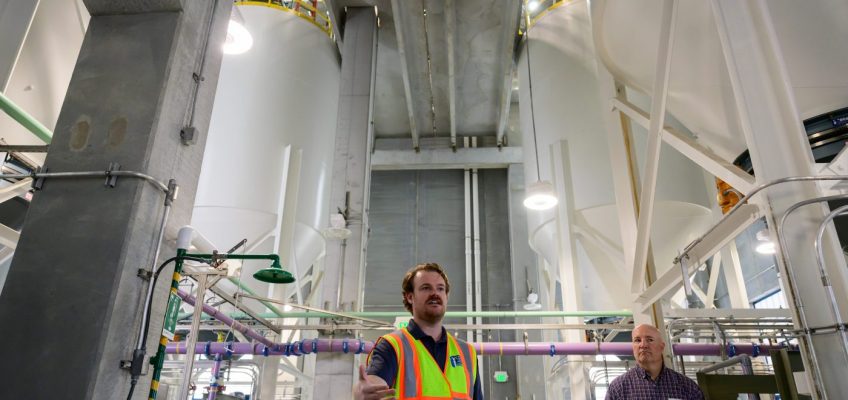When St. Paul Regional Water Services set about designing a replacement for its century-old McCarrons water treatment plant in Maplewood, it didn’t so much look to its current 450,000 customers as beyond them.
What kind of capacity will its decarbonization and disinfectant basins need as its 14 client cities grow in population and new cities sign on? How might the utility combat threats to the east metro’s water supply that might not be known for years or even decades to come?
For designers, one key answer to the latter question was “ozonation” — the process of bubbling ozone gas through water as an added disinfectant in a long line of water purifiers, clarifiers, softeners and enhancers, ranging from lime and fluoride to chlorine and ammonia. For the first time since launching as a public utility in 1882, St. Paul Regional Water is purifying its water with ozone, a tool it’s added to a growing toolbox of approaches toward drawing water from the Mississippi River and its watershed and purifying it until every drop is safe to drink.
“We don’t need ozone to operate this plant,” said civil engineer Eric Noe, who is taking over as project manager for the new McCarrons water treatment plant as remnants of the old operation are demolished or repurposed. “It’s kind of like icing on the cake. But for the next contaminant bogeyman that we don’t yet know about, ozone is already part of our treatment.”
$250M investment in water quality
After three years of planning and four years of construction, St. Paul Regional Water officials threw open the doors on Thursday to what’s being billed as the treatment plant of the future — a $250 million investment in water quality infrastructure for St. Paul and more than a dozen neighboring cities and townships. To pay for the treatment plant, St. Paul Regional Water has gradually increased rates by 25% or more since 2021.
Constructed next to the century-old McCarrons plant on Rice Street, the new water treatment plant represents the largest capital undertaking in the 143-history of St. Paul Regional Water as a public utility.
The project was led by the design-build team of Jacobs, which is based in Dallas working alongside PCL Construction and Magney Construction. Brown and Caldwell, as well as Stantec, served as the utility’s advisors.
“We’re on schedule. We’re a little bit under budget. We’re making great water,” said project manager Will Menkhaus, who is being promoted to assistant general manager for St. Paul Regional Water Services. “And at the end of the day, there were no change orders. … The key thing that jumps out has been a virtue that our society has largely forgotten or even at times labeled a vice, and that’s compromise.”
The old McCarrons water treatment plant has been the sole producer of water for the utility’s clients since 1920, producing an average of 40 million gallons per day — enough to cover a football field in 93 feet of water. The number of gallons drops to about 30 million in winter and can rise as high as 60 million in summer. The new plant will maintain many of the same established practices with additional capacity to serve future client cities and treat as many as 84 million gallons of water daily, even if one of its major basins is out of commission.
Among the new amenities: new lime-softening solids contact clarifiers, new recarbonation basins and a new ozonation treatment process for enhanced taste, odor control and disinfection.
Quality testing lab to come
St. Paul Mayor Melvin Carter, center, is joined by St. Paul Regional Water Services general manager Racquel Vaske, to his left, and Board of Water Commissioners President Mara Humphrey, to his right, and other project leaders in a toast celebrating the newly-upgraded St. Paul Regional Water Services McCarron’s Water Treatment Plant in Maplewood on Thursday, Sept. 25, 2025. (John Autey / Pioneer Press)
The project opened with partial demolition of structures in 2022. Up next will be the construction of new water quality testing lab space in a building previously dedicated to flocculation, or getting particles to clump together for easier removal. Final site restoration and landscaping are expected to wrap in coming months.
St. Paul Mayor Melvin Carter, who shared remarks at the ribbon-cutting on Thursday, reminded the audience that 70% or more of their drinking water comes from the Mississippi River and virtually all of it comes from its watershed. The human body, he said he tells students, is upwards of 60% water, meaning that much of each young person’s body was, in fact, composed of the river itself.
“Our bodies are more than half Mississippi River,” Carter said, noting St. Paul Regional Water took “this water treatment plant that has provided water to our community for 100 years, and replace(d) here it with a brand new water treatment plant that will provide clean drinking water to our community for the next 100 years.”
Related Articles
St. Paul: I-94, I-35E closures this weekend, also John Ireland Blvd. bridge work in October
Judge finds Current DJ’s stalker violated restraining order but not guilty due to mental illness
Divided St. Paul council votes 4-3 against 28.5% rent hikes on Ashland Ave.
As St. Paul city council seeks to get handle on police overtime, costs down this year
Lawsuit filed over ICE detention of Omar Jamal, Somali advocate and Ramsey County sheriff civilian officer


Leave a Reply